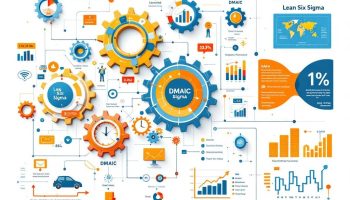
QA strategies and techniques directly influence your business success. By mastering seven essential methods, you’ll prevent costly defects, speed up market delivery, and safeguard your reputation. Companies that implement effective quality assurance practices gain competitive advantages through lower development costs, happier customers, and smoother operations.
Why QA Strategies Matter for Business Success
QA strategies and techniques directly impact your organization’s bottom line by preventing expensive defects, accelerating time-to-market, and protecting brand reputation. In today’s competitive landscape, businesses that implement effective quality assurance practices gain significant advantages through reduced development costs, enhanced customer satisfaction, and improved operational efficiency.
The seven key methods—integrating security testing, using AI-powered automation, implementing data-driven frameworks, and others—help you deliver reliable products that meet changing market demands while maintaining compliance standards. As digital transformation speeds up, these QA approaches become critical business differentiators rather than optional technical considerations.
Implementing a structured testing methodology can dramatically improve your product quality while reducing long-term costs. With the right QA strategies and techniques, you’ll position your organization for sustainable growth in an increasingly quality-conscious marketplace.
7 Essential QA Strategies and Techniques: Unlocking Quality Assurance Success
In today’s fast-paced development environment, adopting robust QA strategies and techniques is crucial for delivering high-quality software. This section outlines seven fundamental approaches that can transform your quality assurance efforts and enhance your overall development lifecycle. Each strategy offers unique insights into best practices that can streamline your processes, foster collaboration among teams, and improve the reliability of your applications. From integrating security measures to leveraging AI for automation, these techniques provide the framework necessary for achieving excellence in quality assurance. Explore each strategy in detail to understand how they can be effectively implemented to ensure your software meets both functional and performance standards.
1. Shift-Left Testing Integration
Implementing effective QA strategies and techniques begins with shift-left testing integration, which fundamentally changes when quality assurance happens in your development lifecycle. By embedding QA from the earliest stages of project inception, you can identify potential issues before they become expensive problems. This proactive approach allows for early defect detection and prevention, significantly reducing the cost of fixes compared to traditional end-stage testing.
Shift-left testing encourages stronger collaboration between developers and QA teams, breaking down traditional silos that often hamper project success. When QA professionals participate in requirements gathering and design discussions, they can identify potential quality issues before a single line of code is written. This collaborative approach to quality assurance helps create more robust applications with fewer defects.
Key benefits of shift-left testing include:
- Reduced development costs through earlier bug detection
- Faster time-to-market with fewer late-stage delays
- Improved code quality through continuous feedback
- Enhanced project collaboration between teams
Integrating QA strategies with CI/CD pipelines further strengthens the shift-left approach by automating quality checks throughout the development process, ensuring consistent application of testing standards.
2. AI-Powered Test Automation: Revolutionizing QA Strategies
AI-powered test automation is transforming how QA strategies and techniques are implemented across development lifecycles. Machine learning algorithms now generate test cases that adapt to your application’s unique characteristics, significantly reducing manual test creation efforts. This advanced QA strategy leverages intelligent test maintenance capabilities that can automatically detect and repair broken tests when UI elements change.
Predictive analytics enhances your test coverage by identifying high-risk areas that require additional testing, allowing for more efficient resource allocation. You can implement these QA strategies through platforms that analyze historical test data and recommend where to focus testing efforts.
Automated visual regression testing represents another breakthrough in modern QA techniques, enabling you to:
- Detect subtle UI changes that might be missed by functional tests
- Compare thousands of screen elements simultaneously
- Reduce false positives through AI-based smart comparison
- Generate comprehensive visual reports highlighting discrepancies
The integration of AI in test automation creates a continuous improvement cycle where testing becomes more intelligent with each execution. Your team can focus on complex testing scenarios while AI handles repetitive verification tasks, making your entire QA process more efficient.
Expert Insight: Embrace AI-powered test automation to enhance your QA strategies by leveraging adaptive test case generation and intelligent maintenance. Utilize predictive analytics for targeted testing in high-risk areas, and automate visual regression tests to catch subtle UI changes. This integration streamlines processes and allows your team to focus on complex challenges.
3. Security-First QA Approach
Implementing effective QA strategies and techniques now requires a security-focused mindset from the outset. Modern quality assurance isn’t complete without rigorous security testing integrated throughout the development lifecycle.
Your QA process should incorporate built-in security testing protocols that detect vulnerabilities before they reach production. This approach ensures that potential security flaws are identified alongside functional issues, creating a more comprehensive testing strategy. API security validation has become an essential component of security-first QA, verifying that all endpoints are protected against common attack vectors.
Automating compliance testing helps your team stay ahead of regulatory requirements while maintaining development velocity. Key security testing elements include:
- OWASP Top 10 vulnerability checks
- Authentication and authorization testing
- Data encryption verification
- Session management validation
Establishing zero-trust testing environments creates isolated spaces where security assumptions can be challenged without risk to production systems. This security compliance testing approach allows teams to simulate real-world attack scenarios and validate defense mechanisms.
By prioritizing security within your QA strategies, you transform testing from a quality checkpoint into a critical security measure that protects both your systems and user data.
Expert Insight: Adopt a security-first QA approach by integrating security testing throughout the development lifecycle. Incorporate automated compliance checks and zero-trust environments to identify vulnerabilities early. This transforms your QA process into a vital security measure, ensuring robust protection for systems and user data.
4. Performance Engineering at Scale
Implementing effective QA strategies and techniques for performance engineering at scale requires a systematic approach to validate system behavior under various conditions. When conducting load testing with real-world scenarios, you need to simulate actual user patterns to identify potential bottlenecks before they impact end users. This approach provides more realistic results than generic stress tests.
Microservices performance validation has become a critical component of modern QA strategies. You should test each service individually and then evaluate how they perform together, as interactions between microservices often reveal performance issues that aren’t apparent when testing components in isolation. Effective project collaboration between development and QA teams ensures that performance considerations are addressed throughout the development lifecycle.
Cloud-native testing strategies require specialized techniques to account for dynamic infrastructure. Your test plans should include:
- Auto-scaling validation under varying loads
- Network latency simulation across different regions
- Container orchestration performance analysis
- Serverless function response time optimization
Resource optimization testing helps identify inefficient code and configuration issues that waste computing resources. By implementing continuous improvement processes, you can progressively enhance system performance while maintaining reliability as your application scales.
Expert Insight: To ensure optimal performance at scale, simulate real-world user patterns during load testing to uncover potential bottlenecks. Validate microservices individually and collectively, addressing performance issues that arise from their interactions. Incorporate cloud-native strategies and continuous improvement processes to enhance efficiency while maintaining reliability as your application grows.
5. Data-Driven Testing Framework
Implementing effective QA strategies and techniques requires a robust data-driven testing framework to optimize your quality assurance efforts. By leveraging analytics-based test prioritization, you can focus resources on high-risk areas first, ensuring maximum coverage where it matters most. This approach allows you to make informed decisions about which test cases deliver the highest value.
Quality metrics automation transforms how you measure and track testing effectiveness. Instead of manual reporting, database analytics tools can automatically collect and visualize key performance indicators, giving you immediate visibility into quality trends. These automated metrics help identify patterns that might otherwise go unnoticed.
Real-time testing insights enable agile response to emerging issues. When your QA strategies incorporate live data feeds, teams can pivot quickly when defects appear, rather than waiting for end-of-cycle reports. This immediate feedback loop is essential for maintaining momentum in fast-paced development environments.
Risk-based testing approaches complement your data-driven framework by:
- Identifying critical functionality based on business impact
- Allocating testing resources proportionally to risk levels
- Reducing testing time by focusing on high-priority scenarios
- Creating targeted test plans based on historical defect data
Expert Insight: Leverage a data-driven testing framework to prioritize high-risk areas, using analytics for informed decision-making. Automate quality metrics for real-time insights, allowing swift responses to defects. Employ risk-based testing to optimize resource allocation and focus on critical functionality, ensuring efficient and effective quality assurance practices.
6. Cross-Platform Testing Architecture for Advanced QA Strategies
Implementing effective QA strategies and techniques requires a robust cross-platform testing architecture that works across all devices and environments. Your testing framework must accommodate the diverse ecosystem of platforms where your applications will run. Modern QA approaches focus on unified testing protocols that streamline validation across desktop, mobile, and IoT environments.
Begin by establishing a device lab that represents your target audience’s most common configurations. This provides a foundation for your QA strategies to verify functionality across:
- Operating systems (Windows, macOS, iOS, Android, Linux)
- Browser environments (Chrome, Safari, Firefox, Edge)
- Device types (smartphones, tablets, laptops, IoT devices)
- Screen resolutions and orientations
Automation plays a crucial role in cross-platform QA techniques. Parallel testing implementations allow simultaneous execution across multiple platforms, significantly reducing testing cycles. Configure your testing framework to maintain consistent test data and expected outcomes while accounting for platform-specific behaviors.
Mobile-first testing strategies have become essential in modern QA approaches, reflecting current user preferences. Start with mobile validation before expanding to desktop platforms to ensure your core experience works on the most constrained environments first.
IoT device testing integration presents unique challenges for QA teams. Create specialized test harnesses that simulate various IoT environments and connectivity scenarios to verify behavior under real-world conditions.
7. Continuous Quality Monitoring for Effective QA Strategies
Implementing continuous quality monitoring is a cornerstone of modern QA strategies and techniques that delivers value well beyond the testing phase. Your quality assurance efforts shouldn’t end at deployment—they should extend into production where real users interact with your systems. By integrating production monitoring tools, you can track application performance and catch issues before they impact users significantly.
Real-time quality metrics provide immediate feedback on your application’s health, allowing QA teams to validate that their testing accurately reflected production conditions. These metrics help identify patterns in user behavior that might not have been captured during pre-release QA strategies. Key metrics to monitor include:
- Error rates and exception tracking
- Page load times and API response times
- User path completion rates
- Feature adoption metrics
- Server response times
When issues do arise, automated incident response becomes invaluable. Configure your monitoring systems to automatically create tickets, alert appropriate teams, or even implement temporary fixes when certain thresholds are breached. This approach minimizes downtime and maintains user satisfaction.
User experience analytics complements technical monitoring by providing insights into how customers actually use your product. By analyzing these patterns, you can refine your QA techniques to focus on the features and paths that matter most to users, creating a feedback loop that continuously improves your quality assurance process.
QA Strategies and Techniques for 2025 Success
QA strategies and techniques encompass seven essential methods for 2025 success, including:
- Shift-left testing integration
- AI-powered test automation
- Security-first approaches
- Performance engineering at scale
- Data-driven testing frameworks
- Cross-platform architectures
- Continuous quality monitoring
These comprehensive quality assurance methodologies collectively transform how organizations detect defects early, leverage intelligent automation, secure applications, optimize performance, prioritize testing based on data, ensure cross-device compatibility, and monitor quality in production environments.
The Importance of QA Strategies
QA strategies and techniques are indispensable for enterprise organizations seeking to maintain a competitive advantage while managing increasingly complex software ecosystems. Implementing these seven methodologies enables businesses to:
- Significantly reduce development costs through earlier defect detection
- Accelerate time-to-market by minimizing late-stage delays
- Strengthen security postures against evolving threats
- Ensure reliable performance at scale
- Optimize resource allocation through data-driven decisions
- Deliver consistent experiences across all platforms
- Proactively address quality issues before they impact customers and revenue






